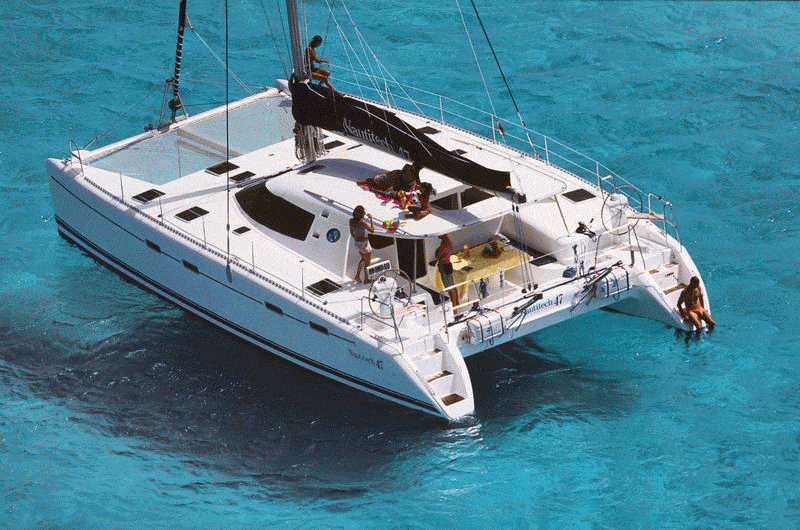
When it comes to sailing performance, excess weight knocks off knots in catamarans. To ensure that the Nautitech 47 is a lively performer, the builder has avoided weighing it down with the heavy, wood-paneled, clubby interior favored by more luxury-oriented brands. A fair amount of white fiberglass is in evidence, and the modular mahogany-finish woodwork is bright but with an economy of embellishment.
Not that the Nautitech’s interior is uncomfortable or unfinished, but it’s obviously designed to be light and easy to look after. Who wants to spend their days buffing bureaus in the boudoir when there’s sailing on the agenda?
Nautitech offers two interior layouts. In both, the port hull has two private cabins, each with a large double berth and a private head with shower. The starboard hull can be had as a mirror image of the portside layout or as an owner’s suite. In the saloon, a wide, U-shaped settee spans two tables, which can be configured in several ways to meet the need of the hour. The galley is aft and looks out to the cockpit.
Nautitech’s designers, Alain Mortain and Yannis Mavrikios, have made some decisions that lean toward seagoing integrity over absolute cruising convenience. The deep sill between cockpit and saloon requires the crew to step over it, but it’s an effective barrier against water. Similar, but lower, sills guard the stairwells to the hulls from the saloon, making them a little tricky to negotiate.
The “Let’s go sailing” approach implied by the no-frills decor is also evident on deck, where steering stations are set on the sterns of each hull, offering the sail-by-feel experience that’s otherwise hard to achieve in a large modern cruising catamaran. Perhaps it’s just this sensation that makes this 47-foot-by-25-foot boat feel less cumbersome than its peers. One criticism leveled at this arrangement is that the helm is out in the elements, but that’s a natural place for it to be on a sailboat. The helm seat is more of a butt rest.
The winches for tending the mainsheet and headsail sheets are aft, clear of the off-duty loungers in the cockpit. Halyards and reefing lines are tended at the mast in what amounts almost to a mini cockpit set into the forward end of the house.
Ergonomically, the deck works very well, except for a little uncertainty dodging the sheet winches when stepping up onto the side decks from the cockpit-a stainless-steel rail around the rim of the hard roof proved very helpful. Steps sculpted into the cabin sides permit access to the roof for the sound of balance; the easier way up is at the mast, where it’s a simpler step up using handholds on the boom.
For our test sail, the breeze topped out at 6 knots. The self-tacking jib made maneuvering easy, and once we cracked off the breeze, the optional sprit-mounted reacher livened up the pace-and the fact that we were making way at all certainly supported the builder’s performance claims.
Under power, the Nautitech 47’s twin 54-horsepower Yanmar engines with saildrives, housed aft of the accommodations under deck hatches, were quiet. The boat slipped along at 9.2 knots with each engine at 3,000 rpm.
As presented, the Nautitech 47 is a sleekly styled platform that serves sunseekers and sailors in equal measure.
Jeremy McGeary is a CW contributing editor.
Nautitech 47
LOA 46′ 4″ (14.12 m.)
LWL 44′ 7″ (13.59 m.)
Beam 24′ 10″ (7.57 m.)
Draft 4′ 5″ (1.35 m.)
Sail Area 1,011 sq. ft. (93.9 sq. m.)
Displacement 24,206 lb. (10,980 kg.)
Water 206 gal. (780 l.)
Fuel 185 gal. (700 l.)
Engines 40-hp. Volvos
Designer Morelli & Melvin
Price $520,000








